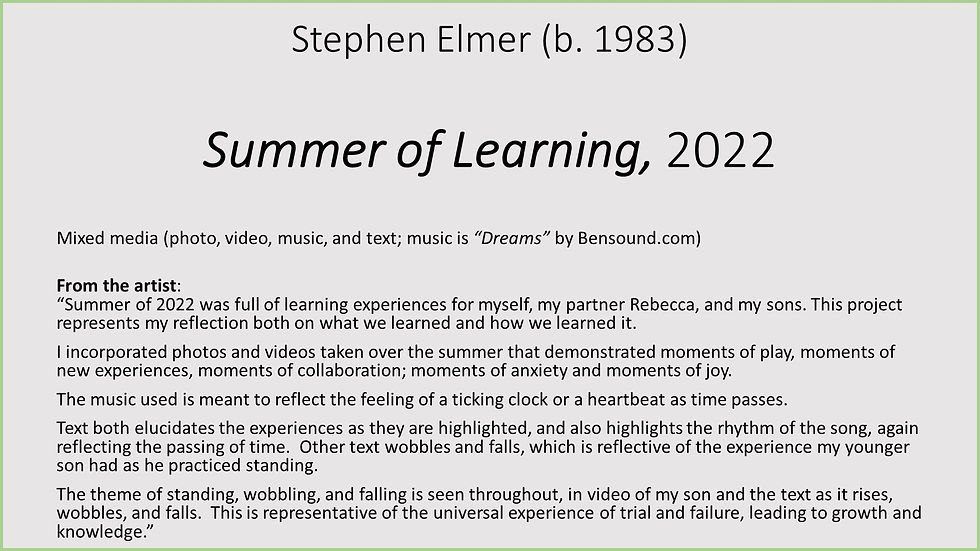Re: design
- elmerst2
- Aug 14, 2022
- 3 min read
For the past several weeks I’ve been working on a student learning experience that gives students a new medium to engage with course concepts. In this post, I’m going to outline a more macro-level redesign I’ve attempted relating to the organization of digital learning spaces students encounter in our medical school curriculum.
A little context first. The medical school I work at has taught in a hybrid/blended format for more than ten years. By hybrid/blended, I am referring to the general class experience where students are sometimes required to be on site, but much of the curriculum can be encountered online. The Online Learning Consortium states, “When the technologies used for education and communication outside the classroom are used to supplant some, but not all face-to-face instruction, reducing the time actually spent in the classroom, the result is a blended classroom course,” (OLC, 2015).
However, my school has had a very decentralized, hands-off approach to curriculum design, allowing faculty to decide how they will structure the course and adoption of technology. Very few standards exist; from my experience, there are three overarching commonalities between the courses:
Communication is primarily transmitted via a consistent LMS (or in the classroom);
Course materials are digitized and shared via the same LMS;
Lectures are recorded and captioned for accessibility and review.

As an instructional designer, one of the things I immediately became aware of was a lack of
consistent structure from course to course. Because of this lack of structure, my goal in a redesign was to provide a consistent pattern of organization in order to provide consistency between courses and attempt to reduce cognitive load on students as they engaged with highly complex course materials. Also, as I mentioned above, the curriculum is highly
decentralized, so one consideration of my redesign was to provide broad guidelines for organization rather than a rigid structure of formatting (fonts, colors, file types) faculty must adhere to (although I hope to push more of the faculty to these types of standards in the future). A key resource I use for online course design is Quality Matters (QM). Quality Matters is an organization which has developed a series of standards (and rubric) to assess course design. I utilized the QM rubric to develop a number of the revisions listed below.

The first thing I did was to provide a consistent folder structure for the courses. I renamed the “Start Here” folder “Course Essentials,” and asked faculty to refer students to that folder for most of their course materials in a specific course introduction. I suggested that faculty place any content that does not have a clear date/deadline associated with it in that “Course Essentials” folder. (This change cemented an already incorporated QM standard of including a Course Overview and Introduction; this was already being attempted by including a “start here” module in the original course structure. It also accomplished QM standards for Learner Support.)
I then created a chronological folder structure where faculty can place weekly updates, overviews of assignments, references to applicable course materials, and tips related to engaging with the course. For example, looking at the “before” screenshot, note that there was a folder specifically built for weekly office hours (which changed each week), one for discussion forums (of which there was one for each week of the course), and for supplemental content by instructor (again, of which there was content for varying weeks). By providing space for time-specific content and communication, students (and faculty) knew where to go each week to find any applicable content for the week. (These changes attempted to improve the course navigation, which is related to the QM standard for Usability). The video below tours the completed revisions.
I will admit that many of the revisions I made were inspired by the design of courses I’ve been taking in the Education Technology program at Michigan State University. I have found the consistent organizational structure of these courses to be extremely helpful in navigating and tracking my progress in the course.
I look forward to hearing from students who encounter the new course org structure, and even more so I am excited to make revisions based on their feedback.
References:
Quality Matters (2020). Specific review standards from the QM higher education rubric, sixth edition. Quality Matters. https://www.qualitymatters.org/sites/default/files/PDFs/StandardsfromtheQMHigherEducationRubric.pdf
Sener, J. (2015, July 7). Updated e-learning definitions. Online Learning Consortium. https://onlinelearningconsortium.org/updated-e-learning-definitions-2/
Elmer, S. (2022, August 8). Build...then renovate!. The (Budget) IT Guy. https://elmerst2.wixsite.com/theitguy/post/build-then-renovate
Elmer, S. (2022, August 14). CEP811 unit 6 complete [Video]. MediaSpace. https://mediaspace.msu.edu/media/t/1_8ic319sz




Comments